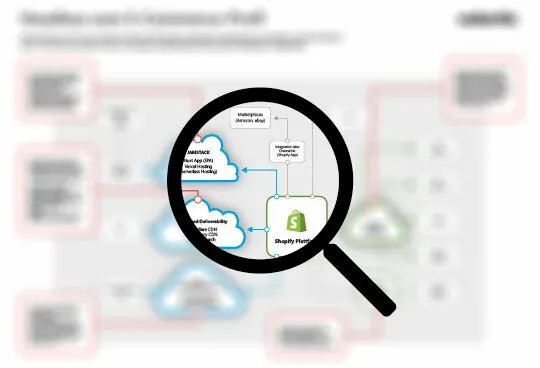How BLACKROLL is getting its e-commerce to peak condition
April 11, 2024

April 11, 2024

Fitness experts and elite athletes have been swearing by them – and by now, they’re also part of the standard equipment in many home gyms: BLACKROLL fascia rolls. Pioneering these active regeneration items, BLACKROLL has carved out a unique product niche and achieved global brand recognition. In just a few years, the Swiss company has rapidly expanded into a leading “healthstyle” enterprise, with a team of 60 employees and a worldwide network of distributors.
BLACKROLL boasts impressive annual sales of approximately 500,000 products through its online channels, drawing over a million active monthly users to its website. A lesser-known fact: Behind this digital success lies a flexible, highly scalable e-commerce system built on Shopify and designed in a headless manner.

During a virtual coffee date with Mirko Mandic, the Circle Lead for E-Commerce at BLACKROLL, we delved into the development of their online store, the brand, and its comprehensive omnichannel strategy. For those interested in discovering how BLACKROLL Headless was set up and the way its microservices architecture enhances the e-commerce experience: You can now read the full interview, complete with an infographic illustrating the unique system landscape.
BLACKROLL tapped into the regeneration and fitness tools market with an innovative approach, introducing a product – the fascia roll – that hadn’t existed in this form before. How were you able to popularize the fascia roll and develop such a thriving business around it?
Roughly a decade ago, the strategy was anchored in sales and marketing initiatives, significantly bolstered by collaborations with elite sports organizations, including the DFB and other major sports associations and clubs. These partnerships for the professional use of fascia products swiftly created far-reaching interest. Today, these networks within competitive sports persist, notably in soccer, but also across other popular sports like handball and ice hockey.
Initially, gyms, medical supply stores, physiotherapists, and strong retail partners served as key multipliers with widespread appeal, significantly enhancing the visibility of our products. Our trainers played an important role as well: We educated recovery professionals on the use of BLACKROLL products through certification programs, who then passed on their knowledge to others. These multipliers continue to play a pivotal role in our marketing and sales efforts. However, in recent years, the importance of digital marketing channels and social media has grown significantly.
BLACKROLL was established as a traditional retail brand, gradually expanding its B2B clientele – with e-commerce initially taking a backseat. When and what prompted the shift towards digital direct sales for your business?
Direct-to-consumer (D2C) sales gained importance for us as a brand in 2019, primarily driven by the decision to nurture a closer relationship with our end customers. The strategic rationale was clear: To achieve a long-term presence at relevant customer touchpoints, we had to invest in our digital business operations. Understanding our end customers and leveraging customer data became imperative to cultivating strong customer relationships. This approach allows us to reduce our reliance on indirect sales models and to diversify our sales channels.
The shift towards direct sales was also connected to the evolution and expansion of our product portfolio. Over time, we expanded our offers to include items designed for both active and passive regeneration, such as pillows, comforters, and mattresses. This diversification and transition from a pure “fascia brand” to a comprehensive regeneration and fitness brand went hand in hand with the evolution of our sales channels.
How has this strategic shift and emphasis on new sales channels impacted your revenue? What percentage of your current sales can be attributed to your online store?
In 2015, the D2C portion of our sales was likely in the single-digit percentage range, with the bulk of e-commerce happening via marketplaces. Even when I joined BLACKROLL five years ago, our success was predominantly rooted in traditional sales channels; e-commerce accounted for less than 20 percent of our total business. Presently, we attribute 40 to 45 percent of our sales to our D2C operations, with the remainder split between marketplaces and physical retail. Adopting an omnichannel approach has offered numerous benefits and allows us to reduce our reliance on any single channel. Nonetheless, this diversification and simultaneous management of multiple channels present their own set of challenges, notably in process management: Each channel comes with specific processes and structures.
How did you address this challenge?
In 2019, we began to systematically enhance our direct sales through digital platforms, focusing on two organizational aspects in particular: human resources and technological improvements. To professionalize our store, we assembled a team equipped with the necessary skills and expertise. This included expertise in performance and direct marketing, e-commerce architecture, and post-purchase operations like customer service, aftersales, and fulfillment processes – all of which had to be taken to the next level. Refining our downstream processes, in particular, was crucial for the management of our parallel sales models.

Which sales and marketing channels are you focusing on today?
We’ve come to realize that an omnichannel approach truly offers us significant added value. The market landscape is becoming ever more challenging for pure D2C models and companies without any networks. I believe, our retail relationships from the early days are affording us an edge over competitors now attempting to retroactively build this kind of offline presence. Presently, our digital footing is solid, spanning our online store, marketplaces, and our app. At the same time, the BLACKROLL app is still in its infancy and serves primarily as a post-purchase resource that helps people derive maximum benefit from our products. For instance, users can create personalized training plans and access a variety of exercises and routines.
You launched your online store in 2015. Why did you choose Shopify as your e-commerce platform?
Shopify is an easy-to-use tool that makes it possible to take the first steps within a short time and with minimal hurdles. The system can also be flexibly expanded and upgraded thanks to the large number of Shopify apps. This made the platform an ideal fit for our vision of expanding BLACKROLL’s digital presence in the coming years.
When and why did you switch to headless e-commerce?
The headless shop was launched in October 2021, with the project starting roughly a year prior. The decision was influenced by multiple considerations, including the crucial aspect of adaptability and the necessity for future-proofing. It was clear that we were going to pursue an omnichannel strategy encompassing various sales models and the potential integration of additional platforms. That’s why we wanted to ensure that our system landscape was ready for any future expansions. The solution was to opt for a microservices architecture that allows for the flexible and independent implementation of various commerce frontends and content configurations.
Another factor was that we serve different content streams: Beyond just the store, we also maintain an extensive content hub, both upstream and downstream, featuring knowledge articles, instructions, and exercises that can be integrated with the store in various ways. This setup creates distinct requirements for the digital infrastructure compared to a traditional store. Consequently, the fundamental concept was to more strongly decouple the processes happening before and after the purchase, thereby affording us greater flexibility to seamlessly merge these streams as needed.
The future internationalization of our sales channels was another key consideration. While our direct sales operations are currently serving Austria, Germany, the Benelux countries, and France, we also have distributors around the globe. The headless architecture empowers us to scale more flexibly on an international level.
How did you go about setting up your headless architecture?
Organizationally, we established specialized teams to support the headless project. The core team consisted of two members each from the e-commerce, marketing, and technology departments. Partnerships with companies like valantic played a crucial role, especially in the early stages, because they provided strategic and technological expertise.
How are you handling the ongoing maintenance and development of your systems now?
We have largely outsourced the maintenance and development of the technical infrastructure; while we boast a skilled in-house team, we also heavily rely on collaborations with partners possessing expertise in key areas such as data, tracking, performance marketing, e-commerce architecture, and the requisite technological setup. valantic, for instance, plays a crucial role in advising and assisting us, particularly in areas such as frontend development of the online store and enhancing the performance of existing systems. This includes tasks relating to interface management, authentication processes, user data handling, monitoring, and testing, as well as strategic planning regarding the implementation and integration of new services.
The terms microservices, decoupled frontends, and headless architecture naturally make you think of the concept of composable commerce. You invested in adaptability and a flexible tech stack at an early stage. Are you actively pursuing a composable commerce strategy?
While we commonly refer to it as a microservices architecture, our system incorporates numerous aspects of what is now considered composable commerce. The approach of enhancing flexibility and adaptability through modular, interchangeable building blocks has definitely guided our strategic and development decisions. The primary motivation behind this was our wish to be able to address future requirements via APIs.

How is BLACKROLL’s e-commerce architecture set up today?
Holger Welzel, Product Owner at BLACKROLL, revealed this to us. Our graphic shows which “extra miles” contribute to the performance and scalability of the system landscape.
What’s next for BLACKROLL? What are your next steps and goals?
We want to further strengthen and expand our online store and D2C business. Simultaneously, we plan to concentrate more on international expansion, including launching stores in new markets. We also see potential for improvement in our B2B commerce. Currently, our B2B store operates in isolation, separate from our headless architecture. We intend to adopt a more structured approach in this regard to more effectively reach our target audiences.
Another ongoing focus is the topic of personalization and everything that follows from that. Our products are highly individual in how and why people use them. This opens up a large field for the personalization of our website and app, as well as our marketing channels and content in general.
We are also further evolving our business models and digital product management strategies. Our goal is to integrate more premium content into our e-commerce offerings and broaden our brand identity. Beyond being known for physical products, we also want to create value through expert content.
Last but not least: Is your namesake fascia roll still the most popular and important product at BLACKROLL?
From a business perspective, our fascia roll’s leading position has been taken by the Recovery Pillow, introduced in 2018. In recent years, we’ve deliberately evolved our brand around the topic of regeneration and systematically expanded our product range to include passive regeneration items. Sleep-related products such as the pillow, alongside comforters and mattresses, now constitute a substantial segment of our business. These products are also particularly well-suited to D2C sales.
Mirko, thank you very much for these fascinating insights!
Are you looking to future-proof your business with a flexible e-commerce system and provide exceptional customer experiences across all digital touchpoints? Let’s connect and discuss how we can help!
Don't miss a thing.
Subscribe to our latest blog articles.